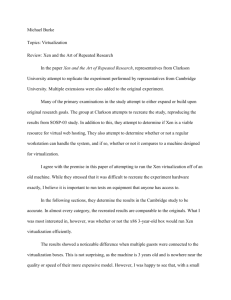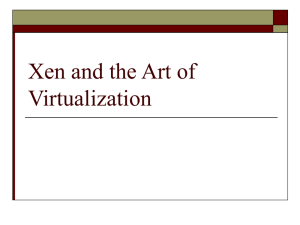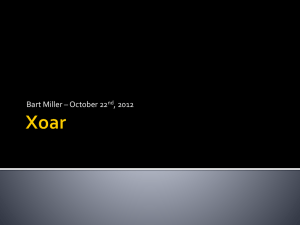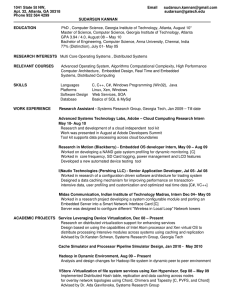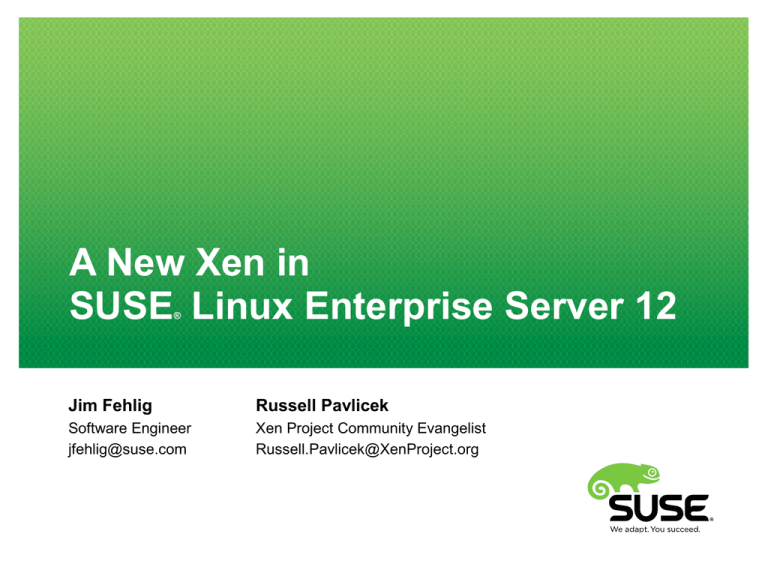
A New Xen in
SUSE Linux Enterprise Server 12
®
Jim Fehlig
Russell Pavlicek
Software Engineer
jfehlig@suse.com
Xen Project Community Evangelist
Russell.Pavlicek@XenProject.org
Agenda
•
•
2
New Xen in SUSE Linux Enterprise Server 12
‒
System changes
‒
New Xen features
‒
Toolstack changes
Xen Project Community Update
grub2
•
/etc/default/grub
‒
GRUB_CMDLINE_XEN_DEFAULT
‒
‒
GRUB_CMDLINE_LINUX_DEFAULT
‒
‒
•
3
Options for xen.gz, e.g. loglvl, dom0_mem, etc
Options for kernel-xen
Run 'grub2-mkconfig -o /boot/grub2/grub.cfg' after changes
Upstream grub supports a Xen PV image
‒
/usr/lib/grub2/x86_64-xen/grub.xen in grub2-x86_64-xen
package
‒
Use as 'kernel' for PV domains
‒
Runs grub against the domain's image, similar to booting physical machine
‒
More secure and cloud-friendly than pygrub
btrfs
•
Host
‒
‒
Default partitioning scheme
‒
'/' gets a small share of the pie
‒
VM images created in /var/lib/{kvm,libvirt,xen}/images
Snapshots
‒
•
Virtual Machine
‒
No support in pygrub
‒
‒
4
Generally not useful to snapshot VM image files
Use grub-xen or another filesystem supported by pygrub
May cause problems in other hypervisors (XenServer) that
don't have btrfs support in their tools
systemd
•
•
5
All services converted to systemd
‒
systemctl restart xendomains.service
‒
rcxendomain restart for back compat
journalctl
‒
journalctl [--follow] --unit libvirtd.service
‒
journalctl /usr/sbin/libvirtd
SLES 12 Xen Stack
®
6
•
Xen 4.4.1
•
kernel 3.12.x
•
libvirt 1.2.5
•
virt-install 1.1.x, vm-install 1.x.x
•
virt-manager 1.1.x
New Features
•
New toolstack!
•
NUMA scheduler affinity
•
Modern qemu
•
Event channel scalability
•
Intel Nested Virtualization (tech preview)
•
SPICE
•
GRUB2
•
qdisk disk backend
•
Hardware support
‒
7
vAPIC, ACPI v5
kernel-xen
8
•
SLES12 retains the “xenified” kernel
•
Changes to kernel-default generally apply to kernel-xen
•
pvops kernel for SLES12 SP1?
New Toolstack!
•
•
9
RIP xm/xend
‒
Officially deprecated upstream in Xen 4.3
‒
Removed from sources in upcoming Xen 4.5
‒
Managed (or persistent) domains are gone
‒
/etc/xen/xend-config.sxp is gone
‒
domUloader is gone
‒
Support for s-expression config format is gone
Welcome xl/libxl (aka libxenlight)!
xl/libxl
10
•
Fast, light-weight, improved concurrency
•
Technical preview in SUSE Linux Enterprise
Server 11 SP3
•
Default toolstack in openSUSE13.1
•
Only toolstack in SLE12/Factory
•
Recommend disabling xend when using xl/libxl
xend vs libxl
libxl
xend
xm
libvirt
vm-install
xl
libvirt
state
state
xend
libxl
state
11
xl vs xm
•
xl is just another (in-tree) libxl client
‒
Don't use with other libxl clients like libvirt!
‒
•
man 1 xl
•
No managed domain support
•
Compatible subcommands
‒
•
•
Exception: new, start, delete, suspend, resume
Behavior adjustable via /etc/xen/xl.conf
‒
12
Use 'xl -f …' to force use of xl with “foreign” domains
man 5 xl.conf
'xl migrate' needs a properly configured ssh
setup on both dom0 hosts
RIP /etc/xen/xend-config.sxp
•
Replaced with /etc/xen/xl.conf (man 5 xl.conf)
xend-config.sxp
xl.conf
network-script
Use distro tools
vif-script
vif.default.script
dom0-min-mem
No equivalent, use Xen
cmdline option
enable-dom0-ballooning
autoballoon
dom0-cpus
No equivalent, use Xen
cmdline option
vncpasswd
Set per domain
device-{create,destroy}-timeout No equivalent
xend-domain-lock
13
No equivalent
dom0-min-mem
•
•
14
Set via parameters to xen.gz
‒
dom0_mem=min:<size>,max:<size>,<size>
‒
dom0_mem=min:512,2G
Recommend fixed dom0 mem size + autoballooning off
‒
dom0_mem=4G
‒
autoballoon=”off” in /etc/xen/xl.conf
‒
libvirt turns off autoballooning if dom0_mem is set
dom0-cpus
•
15
Set via parameters to xen.gz
‒
dom0_max_vcpus=<num>
‒
dom0_max_vcpus=<min>-<max>
‒
dom0_max_vcpus=4-8
xl vs xm Config Format
•
man 5 xl.cfg
•
xm config is a subset of xl
‒
Existing xm config should just work with xl
‒
Exception: embedded python
•
xl supports a new disk config sytax
•
New features only supported in xl format
‒
•
16
SPICE, paging options (hap, shadow_memory),
device model, ...
libvirt supports both formats (plus s-expression)
xl Disk Config Syntax
•
Positional
target, format, vdev, access, devtype
/var/lib/xen/images/dom/disk0.raw, raw, xvda, rw
/foo.iso, raw, xvdc, ro, cdrom
•
Key/value
format=raw, vdev=xvda, access=rw, target=/var/lib/xen/images/dom/disk0.raw
format=raw, vdev=xvdc, access=ro, target=/foo.iso, devtype=cdrom
•
xm disk config syntax still supported
file:/var/lib/xen/images/dom/disk0.qcow2,xvda,w'
•
17
/usr/share/doc/packages/xen/misc/xl-disk-configuration.txt
Disk Backends
•
•
qdisk
‒
Default backend for raw and qcow2 formats
‒
Adjustable cache modes: writethrough, directsync, unsafe
‒
Active upstream community
blkbk
‒
Only used for 'phy:'
‒
To use with raw image files (like SLE11)
losetup /dev/loopx /image/file/path
xl:
phy:/dev/loopx
libvirt: <driver name='phy/><source file='/dev/loopx'/>
18
Disk Backends
•
19
Tap1..N
‒
Slow upstream death
‒
Everything except vhd mapped to qdisk
Log Files
•
/var/log/xen/xl-<dom-name>.log
•
/var/log/xen/qemu-dm-<dom-name>.log
•
/var/log/xen/xen-hotplug.log
‒
20
'set -x' at beginning of /etc/xen/scripts/xen-hotplug-common.sh
Troubleshooting
•
Supportconfig for most issues
•
Increase log level
‒
•
•
21
GRUB_CMDLINE_XEN_DEFAULT=”loglvl=all guest_loglvl=all”
Serial line
‒
GRUB_CMDLINE_XEN_DEFAULT=”loglvl=all guest_loglvl=all
console=com1 com1=11520,8n1”
‒
GRUB_CMDLINE_LINUX_DEFAULT=”console=ttyS0,11520”
Debug keys
‒
xl debug-keys h; xl dmesg
‒
xl debug-keys q; xl dmesg
Regressions
•
pvusb
•
Domain migration from SLE N to SLE N+1 hosts
‒
22
SLE11 SP3 -> SLE12
libvirt Changes
•
•
23
New, stateful libxl driver
‒
Another libxl client
‒
(don't mix and match libxl client applications)
Backwards compatible with legacy Xen driver
‒
Existing domXML should just work after switching Xen
toolstacks
‒
Exception: Currently no dom0!
•
Provides managed domain support
•
Logs
‒
/var/log/libvirt/libvirtd.log
‒
/var/log/libvirt/libxl/<dom-name>.log
libvirt Changes
•
24
New package structure
‒
Minimal libvirt-daemon
‒
Dynamically loaded libvirt-daemon-driver-<driver> modules
‒
Allows constructing a custom libvirt daemon
Xen Config Format <-> libvirt domXML
•
virsh domxml-{from,to}-native <format> /config/path
‒
•
25
Formats: xen-sxp, xen-xm, xen-xl (in progress)
xen2libvirt.py
‒
Convert Xen config to libvirt domXML
‒
Option to import Xen config to libvirt
‒
Option to convert or import a tree of Xen config
‒
Supports xen-sxp and xen-xm formats
virt-install vs vm-install
•
•
•
virt-install
‒
virt-manager's default installation tool
‒
Requires libvirt
‒
Supports remote installations
‒
Does not emit a config file
vm-install
‒
Works with or without libvirt
‒
'--use-xl' option to force xl
Logs
‒
26
~/.cache/virt-manager/virt-manager.log
SLE11 SP3 -> SLE12 Host Upgrade
•
Export domain config
virsh dumpxml > dom.xml
•
Upgrade to SLE12
•
Import domain config
virsh define dom.xml
•
Or use xen2libvirt utility
‒
•
27
xen2libvirt –recursive /var/lib/xend/domains
No live migration of domains from SLE11 SP3
to SLE12 host
Xen Project:
A Vibrant, Innovative Community
Xen Project: Continuing Innovation
29
•
Began its life over a decade ago with the invention of
paravirtualization
•
Moving forward in new directions:
‒
ARM servers
‒
Handheld devices
‒
Embedded applications
‒
Unikernels/Cloud Operating Systems
‒
Better integration with clouds and orchestration technologies
Optimal ARM Hypervisor Design
30
•
Xen Project's design maps directly to the ARM
virtualization extensions added in ARM v7
•
Type 1 architecture works directly in the ARM
Hypervisor Mode
•
No need to switch into privileged Kernel Mode
‒
Increases security
‒
Improves performance
‒
Efficient codebase; a fraction of the code required for x86
Xen Project on ARM: A Perfect Fit!
ARM SOC
ARM Virtualization Architecture
User mode : EL0
Device Tree describes …
Kernel mode : EL1
I/O
Hypercall Interface HVC
GT
31
GIC
v2
2
stag
e
MMU
Hypervisor mode : EL2
Xen Project on ARM: A Perfect Fit!
ARM SOC
ARM Virtualization Architecture
EL0
Device Tree describes …
EL1
I/O
HVC
GT
32
GIC
v2
2
stag
e
MMU
EL2
Xen Hypervisor
Xen Project on ARM: A Perfect Fit!
ARM SOC
ARM Virtualization Architecture
Any Xen
Xen Guest VM (including
(including Dom0)
Any
EL0
User Space
Space
User
Device Tree describes …
Kernel
Kernel
EL1
I/O
HVC
GT
33
GIC
v2
2
stag
e
MMU
EL2
Xen Hypervisor
Xen Project on ARM: A Perfect Fit!
ARM SOC
Dom0
only
only
ARM Virtualization Architecture
Any Xen
Xen Guest VM (including
(including Dom0)
Any
EL0
User Space
Space
User
Device Tree describes …
Kernel
Kernel
PV
back
I/O
PV
EL1
front
HVC
GT
34
GIC
v2
2
stag
e
MMU
EL2
Xen Hypervisor
What Good is ARM?
•
35
ARM servers on the horizon
‒
Low power consumption
‒
Low cooling needed
‒
Higher density
‒
Potential for higher density of servers at lower operational cost
‒
Perfect for the forecast of increasing cloudiness of datacenters
ARM in Embedded and Handhelds
•
Embedded systems
‒
New solutions: Hypervisors in embedded devices
‒
Already have Xen Project in x86 network security devices
‒
Coming soon: Xen Project hypervisor in your car?
‒
•
36
<Wiki page reference here>
Handheld devices
‒
New thinking: Hypervisor on your phone
‒
Why wipe out your life when you can simply erase one of
many identities?
Enabling the Future, Not Dictating It
•
37
We want to enable your vision, not force you into ours
‒
Huge difference between Open Source and closed source
solutions in this area
‒
Many key innovations come from the desire of the community
to meet their own needs
‒
SUSE Linux + Xen Project = the power and flexibility to enable
your vision, regardless what it looks like
‒
Regardless of cloud: SUSE Cloud, OpenStack, CloudStack, OpenNebula
‒
Regardless of orchestration: Xen Orchestra, ConVirt, virt-manager
Unikernel: Powering Next Gen Clouds
•
Xen Project leading the way with Mirage OS
•
Unikernels employ small, secure, packaged VMs
‒
Many advantages of Docker but with smaller instance sizes
and very high security
‒
Potential to power much higher density clouds with improved
security
‒
Not just Mirage OS from Xen Project, but support for many
others
‒
38
OSv, HaLVM, LING (formerly Erlang-on-Xen), ClickOS, and more
Unikernel Approach: Mirage OS
39
Unikernel Approach: Mirage OS
40
Unikernel Approach: Mirage OS
41
Unikernel Results from Mirage OS
•
Contained: easy deployment and management
•
Compact: smaller attack surface, sub-second boot
•
Efficient: Scales to 1000s of VMs per host
•
Amazingly small footprints for appliances!
•
42
‒
DNS server: less than 500 kilobytes
‒
Webserver: less than 700 kilobytes
‒
Openflow switch: less than 400 kilobytes
More information at: http://www.openmirage.org/
Questions?
- XenProject.org
- suse.com/documentation/sles12/
Thank you.
44
45
Unpublished Work of SUSE LLC. All Rights Reserved.
This work is an unpublished work and contains confidential, proprietary and trade secret information of SUSE LLC.
Access to this work is restricted to SUSE employees who have a need to know to perform tasks within the scope of
their assignments. No part of this work may be practiced, performed, copied, distributed, revised, modified, translated,
abridged, condensed, expanded, collected, or adapted without the prior written consent of SUSE.
Any use or exploitation of this work without authorization could subject the perpetrator to criminal and civil liability.
General Disclaimer
This document is not to be construed as a promise by any participating company to develop, deliver, or market a
product. It is not a commitment to deliver any material, code, or functionality, and should not be relied upon in making
purchasing decisions. SUSE makes no representations or warranties with respect to the contents of this document,
and specifically disclaims any express or implied warranties of merchantability or fitness for any particular purpose. The
development, release, and timing of features or functionality described for SUSE products remains at the sole
discretion of SUSE. Further, SUSE reserves the right to revise this document and to make changes to its content, at
any time, without obligation to notify any person or entity of such revisions or changes. All SUSE marks referenced in
this presentation are trademarks or registered trademarks of Novell, Inc. in the United States and other countries. All
third-party trademarks are the property of their respective owners.

